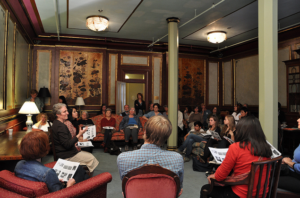Today’s post comes from Nicole M. Roylance, Coordinator of Public Education and Information.

This Sunday we will celebrate Father’s Day. Across the country, men will be rewarded for their paternal efforts with neckties, greetings cards shaped like neckties, and other “masculine” gifts. Walking through the galleries this morning, I was reminded of artists in our collection who were inspired by their artist fathers.
In her groundbreaking 1971 ArtNews essay, “Why Have There Been No Great Women Artists?”, Linda Nochlin, Vassar College class of 1961, pointed to the long art historical tradition of artists grooming their sons to succeed them. Nochlin wrote,
“Despite the noteworthy and dramatically satisfying cases of the great father-rejecting revoltes of the nineteenth century, one might be forced to admit that a large proportion of artists, great and not-so-great, in the days when it was normal for sons to follow in their fathers’ footsteps, had artist fathers. In the rank of major artists, the names of Holbein and Dürer, Raphael and Bernim, immediately spring to mind; even in our own times, one can cite the names of Picasso, Calder, Giacometti, and Wyeth as members of artist-families.”

Picasso, Calder, Giacometti, and Wyeth are all represented in our collection. Pablo Picasso was taught to paint and encouraged by his father, Don José, an art teacher who recognized his son’s genius early-on. Alexander Calder, well-known for his mobiles and stabiles, was preceded by his grandfather, Alexander Milne Calder, who is best known for the sculpture of William Penn on the top Philadelphia’s City Hall, and his father, Alexander Stirling Calder, who completed many public commissions around Philadelphia. Alberto Giacometti’s father, Giovanni Giacometti was also a painter and Andrew Wyeth’s father was the well-known illustrator, N.C Wyeth.


Nochlin demonstrated through her essay forty years ago that these famous relations are more than interesting trivia. Nochlin dispelled the myth of the artist emerging from the womb destined for greatness. Instead, Nochlin illuminated the long tradition of fathers and sons, perhaps without intention, often excluded daughters from following in their father’s footsteps. Nochlin questions, “What if Picasso had been born a girl? Would Senor Ruiz have paid as much attention or stimulated as much ambition for achievement in a little Pablita?”





Thanks for revealing your ideas. I’d personally also like to express that video games have been at any time evolving. Modern tools and revolutions have aided create genuine and fun games. These entertainment games were not that sensible when the concept was being tried. Just like other kinds of technological know-how, video games way too have had to advance by many generations. This itself is testimony towards the fast development of video games.